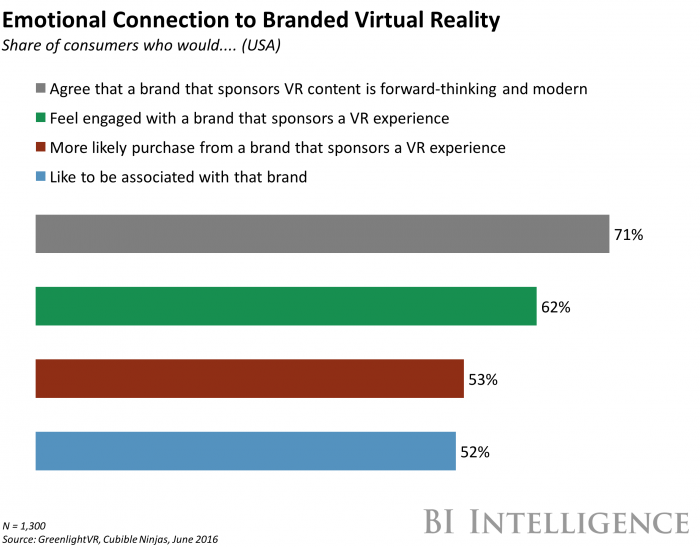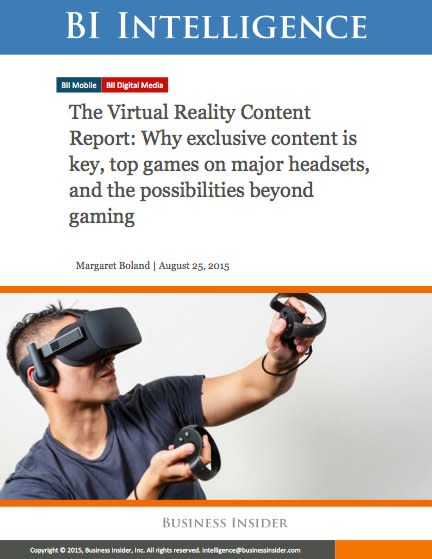IAB interviews pros on virtual reality's potential
This story was delivered to BI Intelligence "Digital Media Briefing" subscribers. To learn more and subscribe, please click here.

BI IntelligenceThe Interactive Advertising Bureau (IAB) released a report exploring the potential of virtual reality (VR) in digital advertising. The report consists primarily of key takeaways from interviews with two dozen thought leaders in advertising, publishing, VR and platform development, as well as a number of VR case studies in the appendix. Sections of interest are VR’s strengths in relation to storytelling, the barriers that are impeding broad adoption, and some of the immediate opportunities for advertisers.
VR’s use for immersive storytelling, shopping, and product demonstrations are core benefits of the new technology. Engrossing consumers is crucial in today’s world of inattention and distraction, where consumer focus is regularly diverted by the clutter of screens that surround them. Yet VR brings a viewer completely into a story, demanding deep focus and full attention, which often leads to a more strongly felt experience. Each of these elements open new opportunities in advertising and experience marketing.
For now, VR remains a niche offering, with several factors that are hobbling its growth. VR's rate of adoption is slow, and not broadly distributed. Broad-based distribution of VR is threatened by the high cost of equipment, the social stigma of a closed experience cut off from the rest of the "real" world, and the fact that VR is a standalone medium that can't easily be adapted for or from other existing video assets. The report also urges caution not to raise expectations for VR too high. First impressions are critical, and consumer expectations to be dazzled by the technology could result in disappointment and slower adoption.
On the advertising front, there are two main takeaways from the report:
The VR advertising opportunity remains a mystery. With VR being a relatively new platform, we are still in the early stages of figuring out how to use the technology for advertising, and make the most of VR’s immersive capabilities. One of the frustrations so far is that VR's currently limited audience necessarily leads to monetization challenges.
360-degree video will be the way in the near future. IAB respondents believe more brands will engage in 360-degree video in the next two years. This kind of content can be enjoyed in full through smartphones, and Facebook and Google's support for 360-degree video will continue to help the format's growth. Other forms of VR advertising mentioned are 2D digital billboards, 2D video and TV spots, but the article doesn't elaborate on the creation of VR from a 2D plane.
The tech industry has promoted the prospect of VR for the past few decades. But only now, with headsets backed by big names like Sony and Facebook, is VR finally becoming a concrete product with mass market potential. While VR technology is largely associated with the gaming industry, the platform offers a new set of content opportunities in entertainment, advertising, and more.
But where is it all going?
Margaret Boland, research analyst for BI Intelligence, Business Insider's premium research service, has compiled a detailed report on virtual reality content that examines how various VR headset categories will shape VR content development and looks at the trajectory for mobile gaming revenues to get a sense of how spending on VR content might develop. The report also lays out what types of content users and developers can expect on VR platforms, including gaming, video entertainment, and advertising.
Here are some key takeaways from the report:
VR headset manufacturers are driving both the development and distribution of VR content by investing significant technical and monetary resources in developers, in an effort to build up an exclusive content library.
High demand for VR headsets by mobile and console gamers will fuel demand for VR content. The VR content market will take an increasing portion of the mobile gaming software industry.
Beyond gaming, VR video entertainment will remain short form until demand for VR headsets increases.
Ads featured on VR headsets will likely have higher view-through rates than standard video ad spots.
Other industries are also beginning to experiment with VR content. Travel companies, publishers, e-commerce merchants, and social platforms are beginning to see potential in this new category.
VR content faces major hurdles that could keep developers from investing: The VR experience must be good enough for people to take up the devices. In addition, developers need to know that a sufficient user base exists to be worthy of the resource investment in VR content.
In full, the report:
Provides a breakdown of each type of VR headset, what platforms they run on, and how content will differ for each.
Includes estimates for global VR headset shipments by category.
Includes a mobile gaming forecast to give a sense of the most important market that will drive spending on VR content in the next five years.
Lays out what other industries are developing VR programs.
Discusses some of the potential barriers that could dissuade developers from investing in VR content.
To get your copy of this invaluable guide to the VR universe, choose one of these options:
Subscribe to an ALL-ACCESS Membership with BI Intelligence and gain immediate access to this report AND over 100 other expertly researched deep-dive reports, subscriptions to all of our daily newsletters, and much more. >> START A MEMBERSHIP
Purchase the report and download it immediately from our research store. >> BUY THE REPORT
The choice is yours. But however you decide to acquire this report, you’ve given yourself a powerful advantage in your understanding of the world of VR.
See Also:

 Yahoo News
Yahoo News 


